Paris Fashions January 1888
Mrs. Johnstone describes in glorious detail, the art of Portrait Painting, Dress Styles, Tea Gowns, Evening Wear, Wedding and Bridesmaid Dresses, Hats, Bonnets, Fair dressing, and Accessories, fully illustrated with the extraordinary costumes worn by the Parisian opera star, Mme. Sarah Bernhardt during her performance of “La Tosca.”
The Art of Portrait Painting
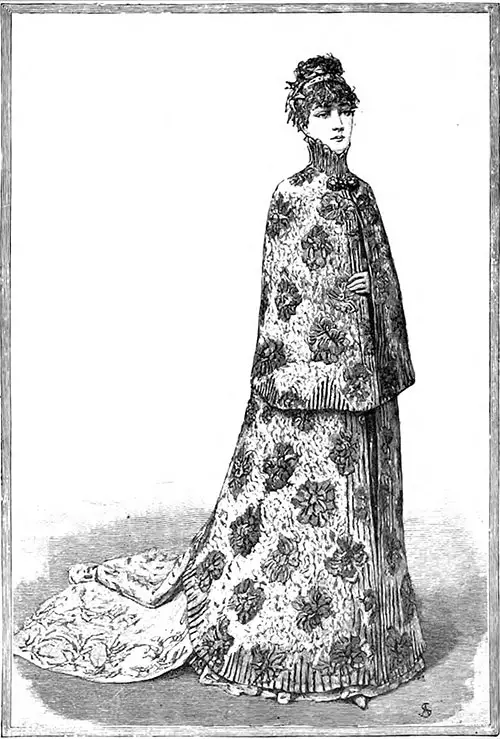
Mme. Sarah Bernhardt In La Tosca
Artists have now returned from their holiday rambles, and are once more confined to their studios, where they are actively preparing some intended masterpiece to be hung this spring, if possible, in the Salon.
Many, no doubt, are throwing on the canvas sketches of magnificent conceptions, either as bright reminiscences of their wanderings, or as outcomes of their warlike or peaceful tendencies.
But many limners, too, will again this year put all their ambition in portrait-painting, a branch of the art which is sufficiently popular to call for a few practical hints, addressed to women who are anxious to have their portrait taken.
An important point to be remembered is that the choice of a good portrayer is as difficult as that of a dressmaker or milliner. Every painter is not endowed with a keen eye for facial types and expression; the graphic delineation of an individual is truly a specialty, which, however, does not always ensure success in every case.
Man's plastic ideals vary so much! Cold classicism is quite opposed to enthusiastic romanticism; each method may produce a faithful rendering of the features and attitudes of every human type, but in an entirely different treatment, which contributes to the pleasing aspect of the picture.
The name of a reputed portrait-painter is therefore not always a sure guide, as proved by too frequent instances of painters treating in accomplished style the sharp accentuations of male figures, and failing entirely in the representation of the soft, graceful, though often insignificant expression of women.
Artists mostly treat their feminine models according to their own views, with little regard for the manner and style of the sitter; thus one man, despising every decoration, every accessory, merely draws the likeness with a few bold strokes, set off with sober coloring only.
The result may be a wonderful achievement of the portrayer's skill, but it is seldom flattering to the model, whose defects, and imperfections it fully exposes without the slightest attempt at concealment.
Another painter, on the contrary, surrounds his model with gay and tasteful draperies, bright flowers, pet dogs, birds, and rich wraps, deftly arranged to conceal some faulty line or reveal some beautiful curve.
In this wise, the sitter is represented with her features truthfully drawn, but either embellished or softened down by the accompaniment of the assorted items which form a part of herself and countenance.
Hence women must first study their own peculiar style and carriage, then compare the works of the various celebrated masters of portraiture. Next comes the choice of the dress. Pretty blondes, with sparkling eyes and piquant looks, had better adopt the costumes of the eighteenth century.
Whilst dark brunettes, with cameo profile and classic type, will look exceedingly well with the Medici collarette and the severe magnificence of the Valois' dress; tall, majestic figures, with refined and regular features, can scarcely do better than don the Louis XIV style, either with the curls à la Sévigné, or the plain bandeaux of the Duchesse de Bourgogne.
It is well, en passant, to remind admirers of the Greek dress that the greatest perfection of lines and profiles is indispensable for wearing with advantage the clinging draperies of this quaint and most graceful attire.
Directoire costumes slightly modernized are recommended to all slender women, with no claim whatever to beauty, but endowed with what is far less ephemeral - a certain cachet and elegance.
In short, the dress selected for a portrait sitter must have a character of its own and recall some special period; even the bodice à la Vierge, with its soft folds crossed over the chest, and knotted on the shoulders with ribbon, will impart a certain grace to the sitter, which will not be given by the severe cut of a tailor-made bodice. Portraits, thus understood, will never go out of fashion, or weary the eye.
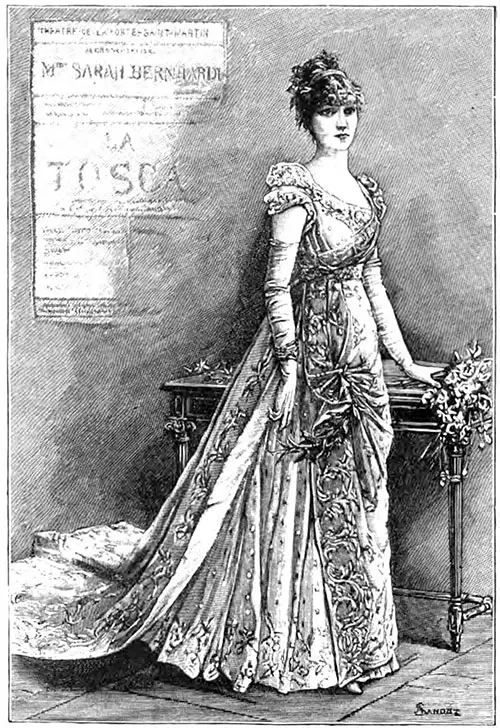
Mme. Sarah Bernhardt in "La Tosta" Act ii
Dress Styles for Discerning Women
But enough of portrait-painting for to-day. As an agreeable change, let us glance at the charming and yet practical novelties lavishly provided here for the grand present-giving season.
The old Maison Laferriere, so renowned during the Empire, is still one of the leading firms where we can always apply for reliable suggestions as to the best styles in vogue, and the best to adopt according to individual type and circumstances.
Here, too, the show-rooms are full of delightful creations, prepared specially for the many festivities given on New Year's Day. A costume for formal visiting is worth mentioning —a bronze velvet redingote with double-breasted fronts, extending as stole ends to the edge of the skirt, which is in kilted faille bordered with a velvet band.
And to wear with this quiet and tasteful dress out of doors a cloak is added of glossy brick-colored plush, shaped at the back as a visite-mantle, and spreading in front in two long straight panels.
At the back and in front a pointed plastron is inserted, showily braided in gold, as are the tabs which button over the pleated front and the sleeves.
Verily our eyes are dazzled with all the soft shimmering of the costly materials, the glowing reflection of the colors, and the brilliancy of the jet and tinsel trimmings.
Nothing can be more gorgeous than this metallic embroidery, glittering with the brightest shades on a reception gown of olive-green velvet, with its skirt straight at the back, and gracefully draped in front between side panels, round which are arranged the flashing ornaments, as well as along the point at the back and the outside seam of the sleeves.
The bodice, opening V shape, can be made quite high at will by a special arrangement of the plastron.
The Elegant Tea Gown
Parisian women are very partial to the easy and flowing princess shape of what in England is called a "tea gown," and which is here much adopted for home wear.
A lovely model of this kind, in pale pink lampas, is cut like a redingote à la Lamballe, and is edged round the hem with a costly marabout trimming, quaintly describing petals of pink carnations. This garment recedes to display a blouse of white lace, brilliant with an outlining of gold thread.
Evening Wear
The costumes for evening wear are not neglected, as will be seen by the following descriptions of four models, which can be worn either at the opera, a ball, or dinner-party.
A silk gauze drapery exquisitely embroidered, is thrown over a skirt of snowy white satin. This transparent material is also used for the small puffed sleeves of the low bodice, which is like the train in Pekin silk embossed with white and narcissus-yellow velvet.
The sash and butterfly bows are in yellow satin, which warm tint sets off admirably the whiteness of the gauze and satin. For a young lady, a pink tulle frock trimmed with Mechlin lace ruchings is most picturesque, so gracefully is it looped up with tufts of roses.
Water-green and pink appear a favorite combination of colors for dressy occasions. This fashionable green, in figured silk, is most effectively crossed with wide stripes of satin or plush, alternately displaying the delicate hues of the tea or Bengal roses, and is caught up à la Dauphine, over a skirt of white China crape, or silk gauze encircled with broad ribbons of pink watered-silk.
Matrons in Paris show a preference for heavy and costly materials in somber hues, and for one of these dames a coat has been designed in flax-blue velvet mounted with broad panels, which are slashed on each side to display a skirt of white satin, with a splendid pattern in raised gold.
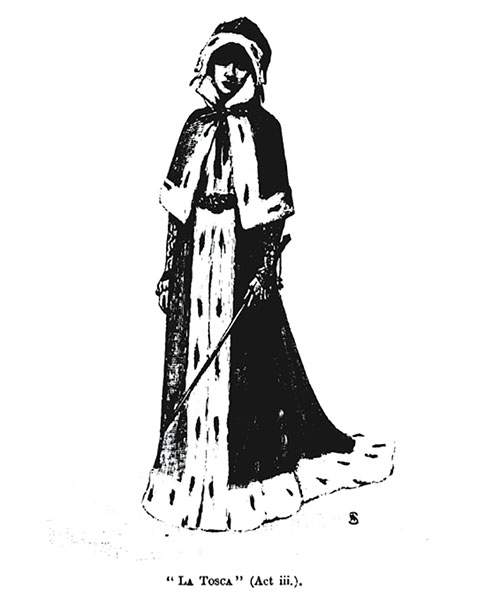
Mme. Sarah Bernhardt in "La Tosta" Act iii
This rich material also forms the stomacher in front of the bodice. A black velvet polonaise is most suitable for half-mourning wear; it opens over a skirt of white satin covered with wave-like draperies wrought with silver.
Long enveloping pelisses in the new moire plush, Genoa velvet, and even lampas, are still in great vogue, for evening receptions, as well as for drives and official calls; they often replace those in seal or otter fur less dressy and yet slightly too heavy for walking.
Indeed, the generality of French élégantes prefer the trim little jackets in otter fur or braided cloth; but the fleecy pile is by no means losing its popularity—far from it; it is now largely used by all classes of society on every kind of ordinary and full-dress garments, as it can be bought at a trifling cost, thanks to the wise and untiring energy of manufacturers, who have not only found the secret of dyeing in all tints of the rainbow the skins of many domestic and wild animals, but have also discovered how to imitate by weaving nearly every one of the furs required by Fashion's laws.
Long boas encircling the throat, and falling over cloaks or gowns, decidedly prevail this winter, they seem to harmonize well with the Empire fashions, and the turban-folded capotes, and they are universally adopted, as being found most be coming to their wearers, and in correct taste with prevailing styles.
They even are to be seen on the stylish morning and tea-gowns in white vicuna or cashmere, which now are ornamented with tasteful smocking on either Indian gauze or silk crape.
Wedding Gowns and Bridesmaid Dresses
Wedding costumes have a charm of their own, and a description of them is always welcomed with delight either by rich or poor, old, and young, single, or married.
At a recent aristocratic marriage, the bride's mother was wrapped in a long and narrow cloak, in reptile-green moire silk, stylishly drawn back to show off a white satin skirt barred with bands of gold and silver embroidery, corresponding with the stomacher of the bodice.
The lovely little bridesmaids were appropriately dressed in jaunty Louis XV costumes, carried out in cream watered silk striped with tiny rosebuds, whilst the tunics, caught up with cream moire bows, exhibited a gauze skirt surrounded above the hem with three rows of cream ribbon.
The bride, as usual, wore a most artistic mass of faille, satin, gauze, and crape, fashioned in all manner of draperies and panels, skillfully interblended with spider web lace and orange-blossoms, without mentioning the diamonds and the pearl ornaments.
Hats and Bonnets
In the matter of hats and bonnets there is little that is new to report since the explicit directions given last month. At Mme. Virot's there is a good display of small capotes, high and pointed, and decorated with ear like loops, aigrettes, coronets, and turban folds.
They are made in both velvet and cloth, but chiefly in red, white, and otter-brown felt to match the costumes, and further enhanced with birds, wings, feathers, and shot ribbon.
Hairdressing and Accessories
Hairdressing for the present offers no striking innovations. Noirat, the fashionable coiffeur, has not been successful with his narrow and elongated headdress, profusely frizzed on the top of the head, and completed with corkscrew curls falling down the back, and simply adorned with a floral cache peigne.
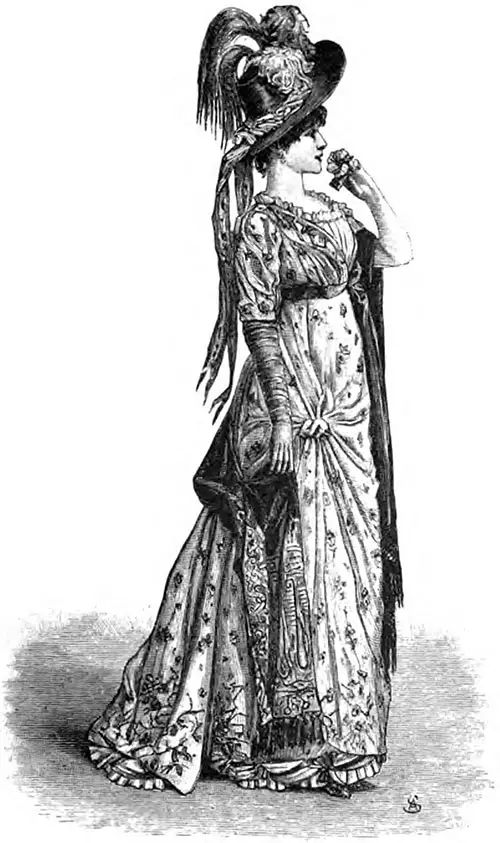
Mme. Sarah Bernhardt in "La Tosta" Act i
These trailing curls are not at all suited to tailor-made costumes and are only in good taste when their wearer is in full dress.
At the Opera, on the night of the celebration of the jubilee of Faust, several handsome women adopted this novel style, which was much remarked, but found trying and unbecoming, hence it is not likely to have many followers.
The ordinary high and pyramidal shaped headdress will yet have a long run with its few varieties; such as the Ceres, in which the nape of the neck is left quite uncovered, whilst the hair, turned up on the top of the head, is rolled in a coronet torsade, the symmetry of which is broken with jewels, soft curls, and either sprays of flowers, or diamond stars fastened in the hair.
Then there is the " Phryne a l'antique," with the hair negligently knotted on the top of the head, and slightly inclined on one side to leave room for tiny tufts of flowers nestling amongst a cluster of small frizzettes.
For morning wear the hair is still divided into two parts and twisted at the very summit of the head into the figure of a double 8, joined together with a fancy pin in tortoiseshell.
Hair ornaments for evening wear are comprised of ospreys, flowers, feathers, aigrettes, filigree insects or butterflies delicately blended with loops of ribbon, gauze, net, jewels, and wreaths à la Ceres, the latest device being, however, luxuriant shot velvet foliage, and flowers studded with brilliants.
The Marvelous Beauty of Mme. Sara Bernhardt
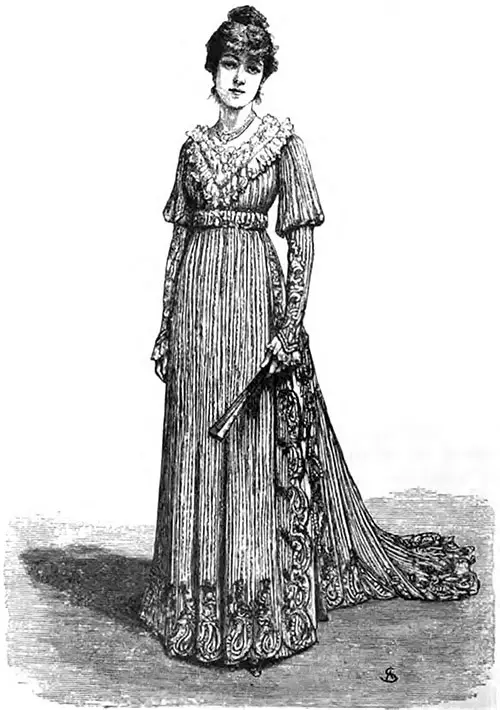
Mme. Sarah Bernhardt in "La Tosta" Act iv
However, the one topic of conversation now in Paris is the marvelous beauty of Mme. Sarah Bernhardt's dresses in La Tosca. In the first act she wears a lovely Directoire dress of pink crepe de chine, embroidered all over with rosebuds.
A scarf of green cashmere falls from one shoulder, and the large hat is adorned with green and pink ostrich-plumes.
In the second act she wears a water green satin tunic, embroidered with gold, over a gold embroidered skirt of white satin.
For the last three acts she has the same costume—a robe of sky-blue mousseline de soie, exquisitely embroidered—and her two cloaks are real masterpieces of design.
The accompanying sketches have been done specially for The Woman's World by M. Adolphe Sandoz, the well-known artist, and they give a very perfect picture of the costumes of the great tragedienne.
Johnstone, Violette, “January Fashions: Paris,” in The Woman’s World, Cassell & Company, Limited, London, Paris, New York & Melbourne, Volume I, No. 3, January 1888, p. 141-144.
Editor's Note: Some terminology used in the description of women's clothing during the 1800s and early 1900s has been changed to reflect more modern terms. For example, a women's "Toilette" -- a form of costume or outfit has an entirely different common meaning in the 21st century. Typical terms applied to "toilette" include outfit, ensemble, or costume, depending on context.
Note: We have edited this text to correct grammatical errors and improve word choice to clarify the article for today’s readers. Changes made are typically minor, and we often left passive text “as is.” Those who need to quote the article directly should verify any changes by reviewing the original material.

